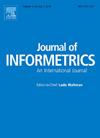A measure and the related models for characterizing the usage of academic journal
IF 3.5
2区 管理学
Q2 COMPUTER SCIENCE, INTERDISCIPLINARY APPLICATIONS
引用次数: 0
Abstract
Based on the underlying usage data given by the Web of Science, we establish a novel metric, termed Uh-index for multi-dimensional assessment of academic journals. Our research objectively examines the empirical and theoretical dimensions of the Uh-index, assessing its validity and potential use in scientific evaluation. For this study, we conducted a quantitative analysis of the Uh-index for 1,603 journals across the fields of physics, chemistry, economics, and management, and explored potential theory models. It reveals that the Uh-index, as a literature metric based on usage data, is more sensitive and discriminatory compared to the h-index, which relies solely on citation data. Additionally, the Uh-index and paper usage data were consistent with both the Glänzel–Schubert and the power-law model. It indicates that the Uh index, as an impact observatory index, aligns with the fundamental principles of scientific knowledge dissemination, thereby holding significant scientific value. It facilitates the quantification of dissemination characteristics of core articles in journals, laying the foundation for a novel approach to categorizing and evaluating journals based on both theoretical orientation and practical application. Finally, from a multidimensional research evaluation perspective, the Uh index offers a transitional dimension for observation, bridging the gap between academic citations and the broader dissemination of research through on social media.
一种表征学术期刊使用特征的测度及相关模型
基于Web of Science提供的底层使用数据,我们建立了一个新的度量标准,称为Uh-index,用于学术期刊的多维评估。我们的研究客观地考察了uh -指数的实证和理论维度,评估了它的有效性和在科学评估中的潜在用途。在本研究中,我们对物理、化学、经济和管理领域的1603种期刊的Uh-index进行了定量分析,并探索了潜在的理论模型。结果表明,Uh-index作为一种基于使用数据的文献指标,比h-index更加敏感和具有歧视性,h-index仅依赖于引文数据。此外,Uh-index和纸张使用数据与Glänzel-Schubert和幂律模型一致。这表明Uh指数作为一种撞击观测站指数,符合科学知识传播的基本原则,具有重要的科学价值。它有助于量化期刊核心文章的传播特征,为从理论导向和实际应用两方面对期刊进行分类和评价的新方法奠定基础。最后,从多维度的研究评价角度来看,Uh指数为观察提供了一个过渡维度,弥合了学术引用与研究通过社交媒体广泛传播之间的差距。
本文章由计算机程序翻译,如有差异,请以英文原文为准。
求助全文
约1分钟内获得全文
求助全文
来源期刊

Journal of Informetrics
Social Sciences-Library and Information Sciences
CiteScore
6.40
自引率
16.20%
发文量
95
期刊介绍:
Journal of Informetrics (JOI) publishes rigorous high-quality research on quantitative aspects of information science. The main focus of the journal is on topics in bibliometrics, scientometrics, webometrics, patentometrics, altmetrics and research evaluation. Contributions studying informetric problems using methods from other quantitative fields, such as mathematics, statistics, computer science, economics and econometrics, and network science, are especially encouraged. JOI publishes both theoretical and empirical work. In general, case studies, for instance a bibliometric analysis focusing on a specific research field or a specific country, are not considered suitable for publication in JOI, unless they contain innovative methodological elements.
 求助内容:
求助内容: 应助结果提醒方式:
应助结果提醒方式:


